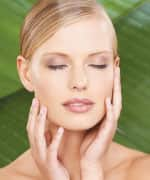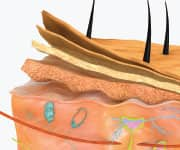Ceramides Create Youthful Skin from Within

Young people’s skin naturally contains ceramides that produce a moist, plump, wrinkle-free appearance.
Oral ceramides have grown in popularity because people feel the moist suppleness of youthful skin return within a short time after taking one small capsule each day.
Clinical studies have shown that an oral phytoceramide dramatically hydrates, smooths, and rejuvenates aging and wrinkled skin.
A proprietary oral ceramide can permeate the skin from the inside out to nourish aging dermal layers analogous to how young skin is maintained.
The four layers of the epidermis contain ceramides that play a critical role in creating the natural barrier that holds in moisture, keeps out infection—and prevents wrinkles.1
First detected in 1884, ceramides have been added to some topical skincare creams since the early 1990s by major cosmetic companies to replenish age-related loss.1 Touted as a way to diminish fine lines, wrinkles, and dryness, their effects were generally modest.2-4
To solve this problem, researchers developed an FDA-approved, oral ceramides capsule that delivers them internally—from the bloodstream—where they move up through the skin’s inner layers to dramatically hydrate, smooth, and rejuvenate aging and wrinkled skin.2,5
Skin-Aging Effects of Declining Ceramide Levels
Ceramides are major skin components that help form the “glue” that holds surface cells together.6,7 Aging skin progressively loses these natural lipids.8-10
Ceramide depletion not only causes skin to wrinkle, but also makes it more susceptible to moisture loss, environmental allergens and skin diseases such as atopic dermatitis.11-13
To overcome the fact that topically-applied ceramides do not sufficiently reach the deeper skin layers, scientists have developed plant-derived ceramides—or phytoceramides—that can be taken orally. This ensures that these potent molecules are absorbed into the bloodstream and inner layers of the skin, effectively working from the inside out to hydrate, smooth, and rejuvenate aging and wrinkled skin.2,5
Additionally, unlike topical face creams, orally ingested phytoceramides reach skin throughout the body.
Until this development, the only way to get ceramides orally was through foods such as wheat and rice. These blood glucose-spiking foods do not provide sufficient ceramide quantities to optimally rejuvenate aging skin.1,2
Early research focused on identifying potentially useful oral ceramides from animal sources.2 Scientists switched to phytoceramides available in grains such as rice, corn, and wheat.2,3 Ultimately, researchers achieved success by using non-genetically modified wheat and produced an extract containing only purified oils.2
This game-changer is a proprietary, wheat-derived phytoceramide extract that can be taken orally to nourish skin cells via the body’s natural route—through the bloodstream into the deepest skin-cell layers and up to the extracellular matrix.2
Effectiveness of Oral Phytoceramides

Researchers then set out to investigate the effectiveness of this wheat-derived ceramide extract in scientific studies.2,5,14 They demonstrated in a laboratory cell study that this extract effectively hydrated human skin and restored its youthful structure—after the skin cells’ protective barrier function had been disrupted.14
In another study, wheat ceramides reduced levels of free radicals in the skin and inhibited elastase enzymes.15 These enzymes would ordinarily destroy elastin and contribute to increased wrinkling and loss of skin flexibility.16
Ceramides have also been shown to inhibit the process by which the skin produces the hyperpigmentation that appears outwardly as age spots and other discolorations of the skin. This suggests that by replacing ceramides from the inside out, oral wheat-derived phytoceramides may inhibit or reverse the uneven pigmentation of skin aging.17-19
These findings suggest that it is possible to dramatically rejuvenate aging skin—simply by swallowing a capsule. However, to conclusively demonstrate wheat-derived phytoceramides’ effectiveness, investigators needed to conduct experiments of the scientifically most rigorous type: double-blind, placebo-controlled human studies.
What You Need to Know
 |
Restore Youthful Skin with Ceramides
- Dropping years off your appearance is now possible thanks to an oral ceramide extract.
- Lipids known as ceramides, which naturally occur in the multiple layers of human skin, may provide the moist, plump, wrinkle-free appearance seen in the young.
- Expensive skin creams have contained ceramides for decades now, but aging individuals find that these surface ceramides deliver only modest improvement.
- A breakthrough, wheat-derived phytoceramide is now available that can be taken orally in capsule form, and studies show that it permeates the skin from the inside out—mirroring how a young person’s skin is nourished.
- Clinical studies have confirmed that this oral phytoceramide dramatically hydrates, smooths, and rejuvenates aging skin.
Clinical Proof of Rejuvenation Effects
In the first clinical trial, 200 mg daily of either an oral placebo or an oral, powdered-phytoceramide extract was given, for three months, to women with dry to very dry skin. Skin hydration was then evaluated using three distinct methods: a special testing machine, a dermatologist’s examination, and the subjects’ own subjective scores.5
Women who had been taking the phytoceramide extract experienced substantial improvement in skin hydration as assessed by all three of these testing methods. These ceramide-taking volunteers also experienced significantly reduced dry patches, roughness, and itching. These changes were not observed in the placebo arm of the study.5
This placebo-controlled clinical trial provided a clear indication that the phytoceramides had successfully made their way through the bloodstream directly into the skin cells, where they provided a powerful rehydrating and rejuvenating effect.5
To secure further confirmation of these compelling results, scientists conducted a second double-blind clinical trial—but this time their aim was to evaluate this wheat-derived phytoceramide extract in its oil form.2
For this study, women with dry to very dry skin took 350 mg daily of either the wheat ceramide oil or a placebo, and results were assessed after three months of supplementation.2 To objectively measure skin hydration, the research team used a special technique known as corneometry. Results indicated that the ceramide oil supplement—but not the placebo—significantly increased hydration of the skin on the participants’ arms, legs, and the body overall. Skin hydration on the arms increased by over 35%, compared to less than 1% in the placebo group.2
Next, volunteers were asked to rate their own personal perception of the effects of their treatments. At each point of measurement in the course of the study, the wheat phytoceramide oil extract was perceived to provide greater improvement in all factors—facial skin hydration, leg skin hydration, suppleness, roughness, uniformity of complexion, itchiness, and overall state of the skin. And these dramatic effects were noted without any significant adverse effects and with a superior level of acceptability.2
Together, these placebo-controlled, clinical trials delivered clear confirmation that orally taken, wheat-derived phytoceramides substantially boost skin hydration, smoothness, and suppleness—reflecting substantial reversal of age-related skin wrinkling, drying, and decline.2,5
Ceramides: As These Molecules Diminish, Your Skin Ages
 |
Ceramides are components of specialized lipid molecules called sphingolipids, an essential element of human skin.45 The ceramides found in both human skin and plants are now known to be structurally similar.29 All four layers of the epidermis contain ceramides, and they play a critical role in skin health by creating a barrier that reduces infection and helps to retain the skin’s moisture, smoothness, and youthful look.29
Over a period of four weeks, new cells created at the deepest epidermal layer migrate upwards to form the top layer of the skin (the stratum corneum) where extracellular matrix lipids inhibit loss of water.46 By the time these cells reach the skin’s surface, they become cornified or hornlike, transforming into protein-rich bricks tightly bound together by a layer of mortar composed of various lipids, up to 50% of which are ceramides.47
The primary function of the epidermis is to generate a relatively impermeable layer to protect the skin from dehydration and environmental stress. Ceramides play a critical role in this barrier function and in the retention of water by the stratum corneum.47 But the aging process reduces the content of ceramides in the epidermal skin layers, which in turn contributes to dry skin and dermatitis.6-11,31
Scientists have shown that, in relation to other lipids, optimal amounts of ceramides in the top layer of the skin are required to maintain youthful and healthy skin.11,47 Wrinkled, dry, irritated, and sensitive skin generally lacks ceramides, and topical application of ceramides has shown limited benefit.
The good news, however, is that orally taken, wheat-derived phytoceramides have been clinically demonstrated to hydrate skin and promote more youthful appearance and smoothness.2,5
Issue of Ceramide Insufficiency
Involved in much more than skin appearance, ceramides are bioactive lipids,20 essential for full functionality of the skin. Their age-related decline represents more than a mere cosmetic problem. Full functionality of the skin helps regulate body temperature, synthesize optimum amounts of vitamin D, and provide critical sensory input from the environment.21-23
With age, declining ceramide levels constitute a health risk due to greater susceptibility to contact dermatitis.9,24,25 Also, the outer layer (stratum corneum) in aging human skin has decreased moisture content26-28 with greater susceptibility to infection.29
Research has shown that the loss of lipid content in human skin that occurs with aging, primarily in the form of a decreased level of ceramides,9 results in reduced structural integrity.7,26,30 Lost structural integrity exposes the skin to a greater threat from environmental assaults, such as low humidity, solvents, and detergents, and a much lower capacity to recover from them.31
Scientists have also determined that the decline in ceramide content in mature skin9 may stem from a decline in the enzyme activity that normally promotes the delivery of ceramides in a usable form to the skin.32
To inhibit this loss of ceramides—and the multiple health risks that occur as a result—it is important to boost ceramide levels not just on the upper surface where lotions sit, but deep inside the skin cells beneath the stratum corneum.
So maintaining youthful levels of ceramides in all layers of the skin achieves more than promoting a better appearance and feel—it powerfully blocks skin infections24 and other skin diseases.9,31
Preventing and Treating Skin Conditions
Skin lipids, including ceramides, comprise a major part of an antimicrobial barrier, the first line of defense against infection. Investigators have found that age-related deterioration of this barrier increases the risk of numerous skin conditions.31
For example, individuals with atopic dermatitis have diminished concentrations of ceramides in the outer skin layer (stratum corneum)9 and have higher concentrations of bacteria, especially Staphylococcus aureus, on the skin surface.33 One study confirmed that the increased Staphylococcus aureus colonization in atopic dermatitis is correlated with a corresponding reduction in ceramides content.34 These bacteria have substantial potential to cause infection if the skin barrier function is disrupted.35-37
Another common cause of potentially serious skin infections is Streptococcus pyogenes, which can cause erysipelas and cellulitis, which are characterized by the spread of the bacteria into the deep layers of the skin.38-40 Also, skin wounds and functionally compromised areas of the skin can easily be infected by another opportunistic bacterium known as Pseudomonas aeruginosa.41,42
The link between diminished ceramides and infection was confirmed when scientists showed that repairing the breakdown in the ceramide barrier, while continuing standard topical treatments, alleviated childhood atopic dermatitis.43 This is especially important, because the topical corticosteroids and other immunosuppressive agents that constitute the mainstays of traditional therapy have significant toxicity, particularly in children.
Further confirmation was documented when researchers treated patients who had contact or atopic dermatitis for eight weeks with a lipid mixture containing ceramides alone or in combination with topical corticosteroids until abatement. Compared to baseline, both treatment groups saw improvements at weeks 4 and 8. But those patients who received the ceramide combination with topical corticosteroids experienced a greater relief than those who used topical corticosteroids alone.44
Summary

Our skin takes a beating day in and day out from solar exposure, pollutants, stress, and aging. Maintaining youthful, resilient skin is a challenge.
Since the early 1990s, expensive facial creams have boasted the addition of ceramides, bioactive lipids to help moisturize and protect the skin. There is little evidence, however, of the effectiveness of topical ceramides.
To solve this problem, researchers developed an oral plant-derived ceramide that moisturizes and supports skin from within the body.2
By Michael Downet
Article extracted from Life Extension Magazine


Social Login